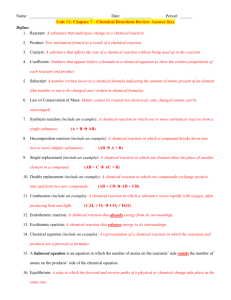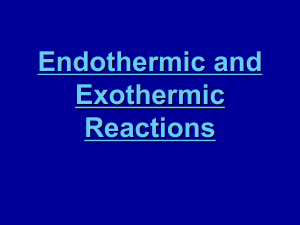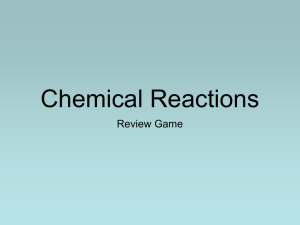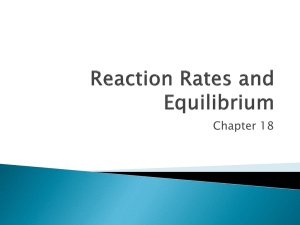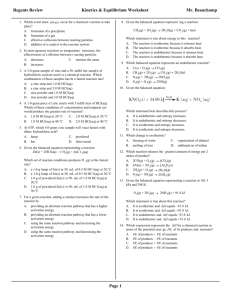Unit 7 Chemical Reactions - Notes
advertisement
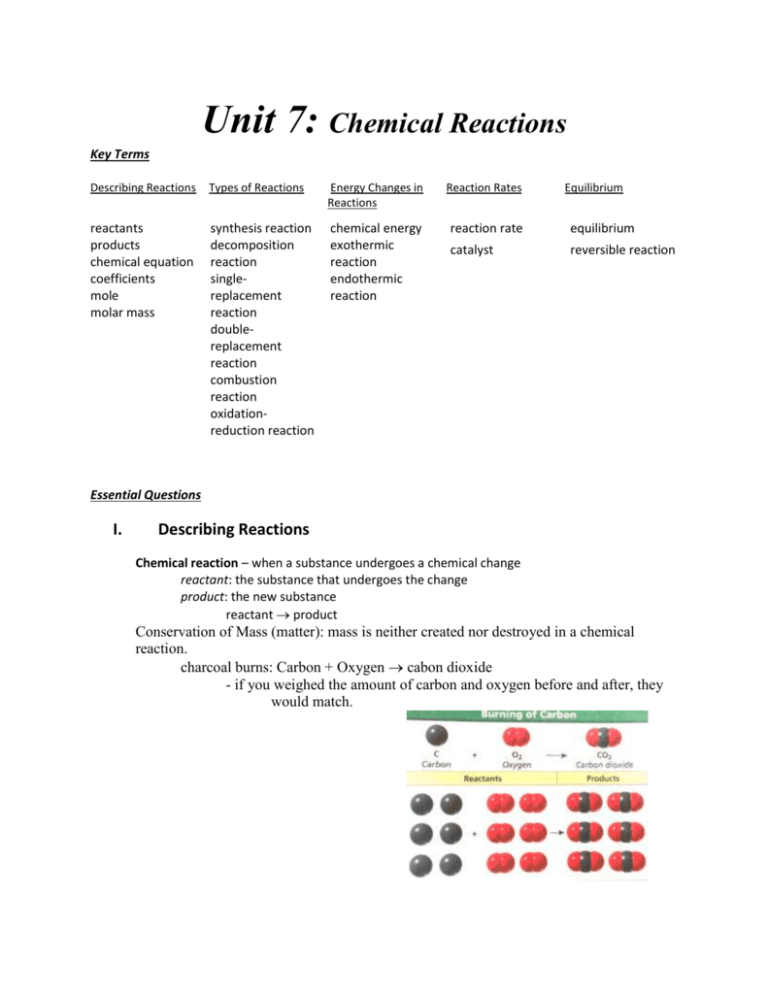
Unit 7: Chemical Reactions Key Terms Describing Reactions Types of Reactions Energy Changes in Reactions Reaction Rates Equilibrium reactants products chemical equation coefficients mole molar mass synthesis reaction decomposition reaction singlereplacement reaction doublereplacement reaction combustion reaction oxidationreduction reaction chemical energy exothermic reaction endothermic reaction reaction rate equilibrium catalyst reversible reaction Essential Questions I. Describing Reactions Chemical reaction – when a substance undergoes a chemical change reactant: the substance that undergoes the change product: the new substance reactant product Conservation of Mass (matter): mass is neither created nor destroyed in a chemical reaction. charcoal burns: Carbon + Oxygen cabon dioxide - if you weighed the amount of carbon and oxygen before and after, they would match. DEMO: light a candle: - wick: chemical change string (organic: containing C) CO2 - wax: physical change Solid Liquid Solid - cover it with glass to starve it of oxygen to put it out. Q: What’s going on? II. Types of Reaction What are the main types of chemical reaction? 1. synthesis reaction: two or more substances react to form a single substance. A + B AB EX: 2Na + Cl2 2NaCl 2H2 + O2 2H2O 2. decomposition reaction: the opposite of synthesis AB A + B EX: Electricity passes through water it decomposes into oxygen and hydrogen gases. 2H2O 2H2 + O2 Calcium carbonate decompose into lime and carbon dioxide CaCO3 CaO + CO2 3. single-replacement reaction: This is when one element trades places with another element in a compound. These reactions come in the general form of: A + BC AC + B EX: One example of a single displacement reaction is when magnesium replaces hydrogen in water to make magnesium hydroxide and hydrogen gas: Mg + 2H2O Mg(OH)2 + H2 4. double-replacement reaction: This is when the anions and cations of two different molecules switch places, forming two entirely different compounds. These reactions are in the general form: AB + CD AD + CB EX: One example of a double displacement reaction is the reaction of lead (II) nitrate with potassium iodide to form lead (II) iodide and potassium nitrate: Pb(NO3)2 + 2KI PbI2 + 2KNO3 5. combustion reaction: A combustion reaction is when oxygen combines with another compound to form water and carbon dioxide. These reactions are exothermic, meaning they produce heat. EX: An example of this kind of reaction is the burning of napthalene: C10H8 + 12O2 10CO2 + 4H2O 6. oxidation-reduction reaction (redox): a reaction in which electrons are transferred from one reactant to another. oxidation : any process in which an element loses electrons during a chemical reaction EX: iron + oxygen iron(III) oxide (rust) EX: calcium + oxygen calcium oxide 2Ca + O2 2CaO (lime) - each neutral calcium atom loses two electrons and becomes a calcium ion with a charge of 2+. Ca Ca2+ + 2ereduction: the process in which an element gains electrons during a chemical reaction EX: as calcium atoms lose electrons during the synthesis of calcium oxide, the oxygen atoms gain electrons. O + 2e- O2* oxidation and reduction always happen together. 7. acid-base: This is a special kind of double displacement reaction that takes place when an acid and base react with each other. The H+ ion in the acid reacts with the OH- ion in the base, causing the formation of water. Generally, the product of this reaction is some ionic salt and water: H(A) + (B)OH ⇌ H2O + BA EX: One example of an acid-base reaction is the reaction of hydrobromic acid (HBr) with sodium hydroxide: HBr + NaOH ⇌ NaBr + H2O How can you identify in the laboratory that a chemical change has occurred? Observations: - production of light / energy - color change - odor produced - precipitate forms - gas produced III. Energy Changes in Reactions Why and how is a chemical equation balanced? Since the “Law of Conservation of Mass” says nothing is lost or gained, you must have the same amounts on both sides. Atoms are arranged in a chemical reaction and the same number of each type of atom is present before and after the reaction. Energy Changes in Reactions Breaking bonds – requires energy Forming bonds – releases energy Does breaking chemical bonds require energy or release energy? What is an endothermic process? (breaking bonds) During a chemical reaction, energy is either released or absorbed. endothermic reaction: a chemical reaction that absorbs energy from its surroundings What is an exothermic process? (forming bonds) exothermic reaction: a chemical reaction that releases energy to its surroundings III. Reaction Rates What factors impact the rate of a chemical reaction? reaction rates are influenced by: - temperature : decrease temp = slow down (spoiling milk) increase temp = speed up (fry egg) - surface area : the smaller the particle size, the more surface area it has. EX: grain dust suspended in the air (max surface area) and oxygen Q: why are silo’s tall and not wide? - concentration : refers to the number of particles in a given volume. More particles, the faster the reaction rate. EX: wash your white socks with a red shirt = pink socks pour in red pigment = red socks - catalysts : a substance that affects the rate without being used up in the reaction In the chemical equation it is written above the reaction EX: What do you do when you are running a fever? (Tylenol ) EX: enzymes function as catalysts for biological functions: Pepsin = in stomach trypsin = small intestine What happens if the stomach is too basic? (drink a bunch of milk) Enzyme activity decreases What happens if acid from the stomach gets into the small intestine? (eat VERY spicy food) - pH drops, enzyme activity drops What does our body sometimes do when this happens? - it says, “Evacuate!” Diariah! IV. Equilibrium Equilibrium – a state which the forward and reveres paths of a change take place at the same rate. Physical equilibrium – pour water into a contain (some evaporates, then condenses) EX: (water) H2O(l) ⇌ H2O(g) Chemical equilibrium – when a chemical reaction does not go to completion reversible reaction: a reaction in which the conversion of reactant into product and the conversion of the product into reactant can happen simultaneously. EX: synthesis of sulfur trioxide (to then make sulfuric acid) from sulfur dioxide (toxic gas) and oxygen: 2SO2(g) + O2(g) ⇌ 2SO3(g) Factors to affect chemical equilibrium: temperature, pressure, and concentration.

